Pine Valley Golf Club
New Jersey, United States of America
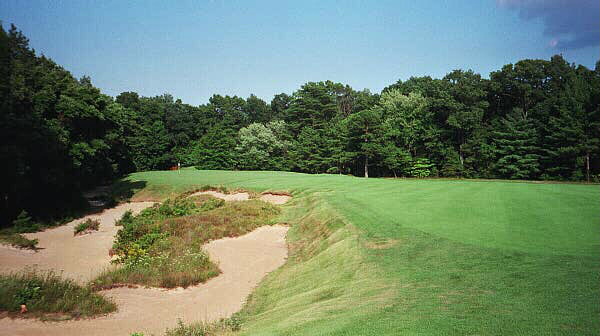
The approach to the 13th green embraces the best that golf course architecture offers: the golfer is presented with strategic options ranging from playing safely to the right to attempting an heroic carry onto the green by going left over the penal sandy scrub.
Pine Valley has long attracted superlatives. It is continually judged as the finest course in the world in large part because many would argue that a) it possesses more world class holes than any other course, b) the finest eighteen green complexes of any course, c) the finest collection of three shotters, d) the finest collection of two shotters (especially those under 370 yards), e) the finest collection of one shot holes, f) the finest three hole start and g) the finest three hole finish. In between, it has a great halfway house!
In addition to it being a famous test of golf, Pine Valley served as a central gathering point for architects to discuss and analyze specific design features during the Golden Age of golf course design. Starting in 1912 when George Crump acquired the property,a who’s-who of architects came, saw, and in some cases contributed to its design: Harry Colt, Hugh Wilson, George Thomas, William Flynn, Charles Blair Macdonald, Walter Travis, Robert Hunter, A.W. Tillinghast, Alister MacKenzie, Donald Ross, William Fownes, Charles Alison and Perry Maxwell. They all appreciated that Pine Valley raised the standard for golf course architecture and these same architects account for the majority of the great courses found in the United States.
And though Colt was paid as an advisor by Crump, and though Crump consulted with many of the architects listed above, and though Crump died before the 12th – 15th holes were put into play, there is no mistake that Crump deserves the vast majority of the credit for the incorporation of so many classic design elements. Crump is the man who found the property, who lived on site and scouredit week after week to find the ideal routing, and who oversaw the detailed construction of fourteen of holes.
The initial 184 acres that Crump found that set the stage for this course is indeed remarkable. Set on sand dunes that bordered the ocean thousands upon thousands of years ago, the property was wind swept and scrub covered when Crump first saw it in or around 1909. One of the first architects to come see it with Crump was Charles Blair Macdonald who immediately noted, ‘Here is one of the greatest courses – if grass will grow.’
And Macdonald knew what he was talking about as the property that he found for National Golf Links of America is the only other property in the world of golf that can attemptto match Pine Valley’s for diversity and inspiration over the full eighteen holes. The same cannot be said for the property at Cypress Point or Royal Melbourne (West) or Royal County Down or even The Old Course at St. Andrews, each of which features nines of unequal merit. However, at Pine Valley, the level of excitement remains at an unsurpassed high from the 1st tee to the last putt on the 18th green, as we see in the hole by hole description below.
Holes to Note
1st hole, 425 yards; Considered the finest 19th hole in golf, the 8,300 square foot green starts as an extension of the fairway and ends as a peninsula with sharp fall offs on all three sides. The demand for clear thinking is immediate: with the front portion of the green ample in width, is the golfer content to be on the front and take two putts to get down? Or is he confident enough to chase after the back hole locations where the green narrows? A wonderful dilemma posed by a bunkerless green site.
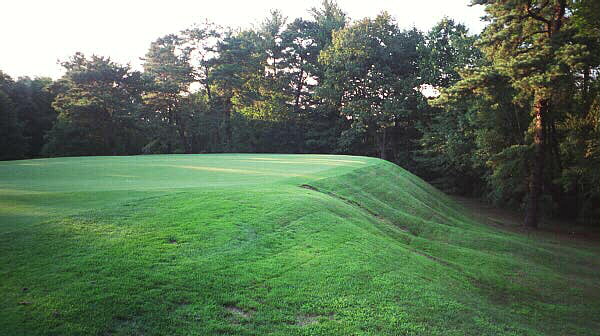
As taken from the right side of the green complex, an approach lost slightly right is kicked away from the green and towards death. A similar fate awaits on the left side and over as well.
2nd hole, 365 yards; Some selective underbrush clearing has recently occurred on a hole by hole basis with the view that finding one’s golf ball and then hitting it is an integral part to the spirit of the game.The search process for a lost ball is quicker and indeed the golfer is more apt to have a recovery shot that he could attempt. The benefit of this clearing was seen when a play-off of six men for two spots arrived at the 2nd tee. Two of the six posted a bogey and a double bogey – and they advanced! The other four men had driven poorly and found their tee balls in the sandy ruts that line either side of the 2nd fairway. They then tried miraculous recovery shots which alas proved their undoing.While this fairway is perhaps the most imperative one to hit on the course, the real terror of the hole for the class golfer is its mammoth putting surface, with its series of waves that run from left to right across the pitched green. Why the contours of this green haven’t been emulated at other courses remains a mystery.
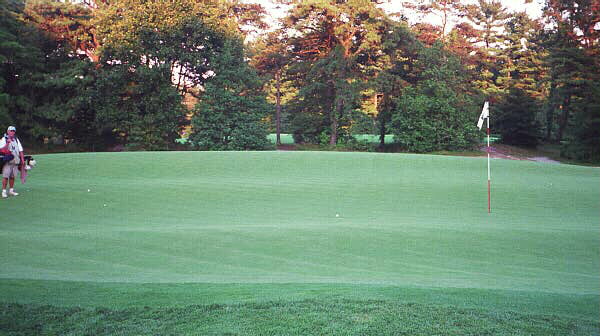
The green contours that make putting so treacherous are evident from the right side of the green. The caddie’s feet are well below the day’s back hole location.
3rd hole, 180 yards; Because of its high right side, the general right to left sweep of the green, and the bunker that protects the left side, many people consider this hole a Redan while in fact it is not. However, it may well offer more options than a Redan. Its front right hole location can be nightmarish but its back left one is lots of fun as the golfer watches from the elevated tee as his draw releases across the green towards it.
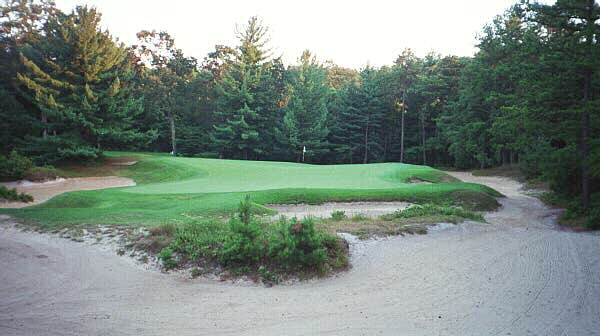
The imaginative shape of the 3rd green offers numerous interesting hole locations.
4th hole, 445 yards; Crump was a master at fitting the green to the hole. Given that the 4th is the second longest two shotter on the course behind the 13th, it comes as no surprise to find the green is open in front and is one of the biggest on the course at 9,700 square feet. The green itself follows the general slope of the land, which is from front to back. Having one’s approach finish near the front hole locations is tricky (as the ball wants to wander to the back) but the the golfer who takes on the dogleg off the tee gains a real advantage by coming into the green with a shorter club.
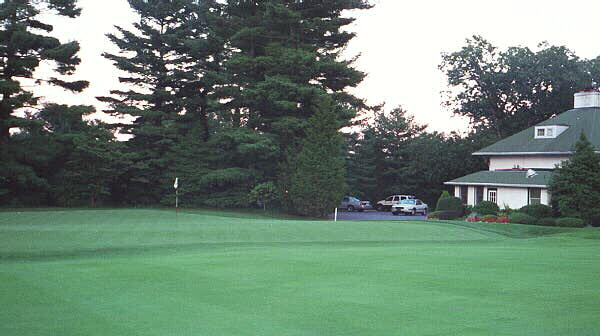
Because of its famous island fairways and greens, Pine Valley has been misunderstood as accepting only an aerial game. The approach to the 4th green is a clear example of the importance that Crump associated with the ground game.
5th hole, 230 yards; At Harry Colt’s suggestion, Crump pushed the green 60 yards further up the hill,thus creating a long one shotter that is considered by many as being the supreme long one shotter among inland courses along with the 9th at Yale, the 13th at The Addington and 6th at West Sussex. Some golfers more closely associate this hole with Pine Valley than any other thanks to its heroic and penal nature. However, other golfers who appreciate Pine Valley first and foremost for its strategic dilemmas may find a dozen or so holes on the course more readily appealing. Regardless, the hole is another example of Pine Valley’s sterling routing as it gets the golfer from the lower 4th green by the clubhouse up to the ridge that the 6th hole plays along.
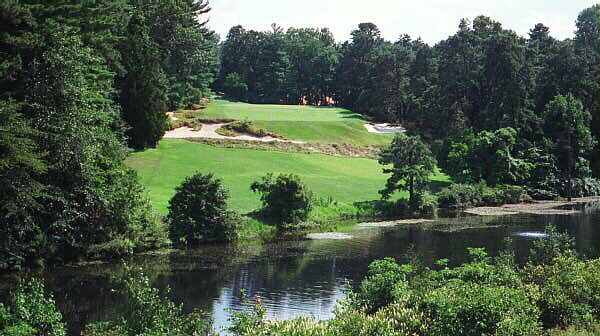
The famous view of the one shot 5th, whose green is well elevated above its tee.
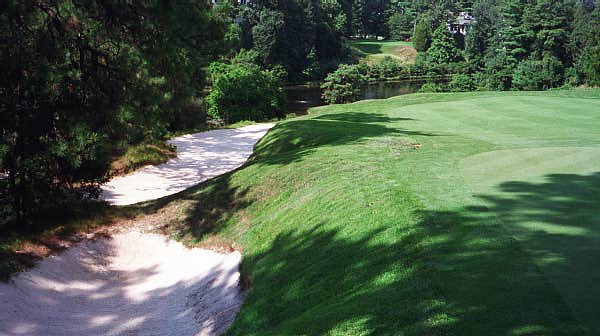
Nothing good happens to the golfer if he misses the 5th green to the right. However, some of the underbrush has been cleared since Gene Litter found misery in there during his 1960s Shell’s Wonderful World of Golf match. Note the fairway short of the green.
6th hole, 390 yards; This dogleg to the right features one of the game’s finest angles of play. To carry the scrub straight ahead off the tee is only 140 yards, but that would leave the golfer well over 200 yards into the green. Conversely, the boldest line requires a carry of 275 yards but the golfer would be left with a little wedge into the green. Regardless of which line the golfer takes, the closer his tee ball hugs the inside of the dogleg (i.e. the closer it is to the trouble), the better angle he has into the green, which is protected on its left front side by a bunker.

The golfer must elect which line to pursue from the elevated tee. The further right he goes, the shorter approach shot he’ll have and the better angle into the green.
7th hole, 580 yards; Relatively speaking, this hole occupies the flattest stretch of property on the course, so to give the hole life, Crump left what would become probably the course’s single most famous hazard – Hell’s Half Acre, which bisects the fairway from the 285 to the 380 yard mark. A.W. Tillinghast was mightily impressed and would later incorporate such a Sahara bunkering scheme into several of his finest three shot holes including the 17th at Baltusrol Lower, the 14th at Five Farms course of Baltimore Country Club and the 3rd at Fenway Golf Club. While Hell’s Half Acre puts pressure on the second shot, it’s actually the tee ball that is crucial for the good player: if the golfer doesn’t find the fairway, he knows that his only play will be to pitch out short of Hell’s Half Acre. The green contours are often overlooked but are among the finest on the course.
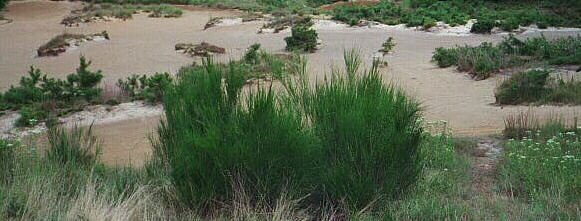
Hell’s Half Acre – with such natural hazards, Pine Valley enjoyed a timeless look from the outset.
8th hole, 320 yards; Given Pine Valley’s fearsome reputation around the world, many first time players are surprised to find that they are likely to have a short iron approach shot into at least four holes (here, the 10th, 12th and 17th). George Crump believed in testing the full range of shots AND he also understood that a ticklish wedge shot could be just as worrisome/vexing as a full blooded wood or long iron shot. Since Crump’s death in 1918, Pine Valley has never once fallen prey to the false quest for length that first gripped America in the 1960s and that is currently ruining such designs as Augusta National. Crump brilliantly kept the 8th short in length, thus guaranteeing that the golfer would have a pitch shot off a tricky sidehill, downhill stance. To compound matters, the tiny green measures a mere 2,900 square feet and now features a false front that Perry Maxwell built. Crump could have easily located the green some 30-40 yards further back (i.e. where the 9th tee is today) but that would have negated the need for the golfer to handle an approach from an awkward stance.
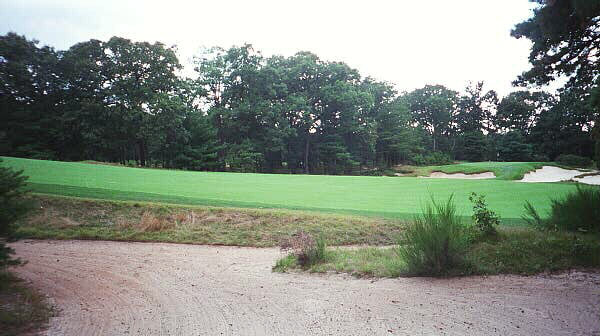
This photograph captures the 8th hole’s primary defenses: the sloping fairway and its tiny green.
9th hole, 425 yards; Unlike many modern courses built today, Crump placed little value in having holes laid out so that the golfer could see everything. In fact, on the 4th, 6th, 8th, 9th, 11th, 13th, 16th, and 17th holes, the golfer is unlikely to see his ball land in the fairway. A lot of earth would have had to be moved to provide the golfer with perfect visuals and Crump saw no reason to do so. Also, on a course where the better golfer can continually seek an advantage by placing the ball in a particular spot in the wide fairways, the concept of the 9th’s dual greens is an an interesting solution to creating angles of play on what would otherwise have been a straight hole. Along with the original 8th green, Perry Maxwell also worked on the left 9th green and his back right hole location is a particularly thrilling one to try and get close to, given that a cliff is only few paces over the green. This green was originally a skyline one with nothing behind it but the growth of the trees to stabilize the sandy soil has negated that feature of the hole.
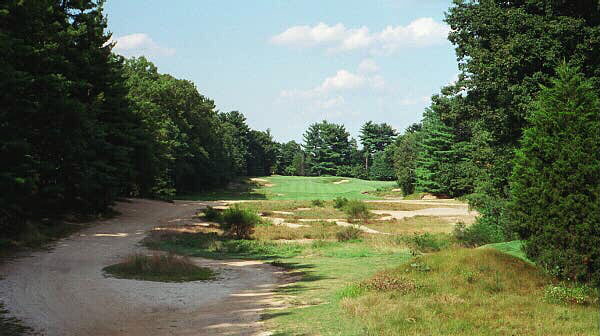
Looks can be deceiving: while the 9th looks tight from the tee, its fairway is one of the widest on the course.
10th hole, 145 yards; While a sub-150 yard hole in a windy location like Royal Troon and Royal North Devon can tax even the best golfer, rarely do inland courses feature such little gems. Amongst inland courses, the authors can only think of the 9th at Myopia Hunt Club and the 7th at Royal Melbourne (West) as being of the same calibre and quality as the 10th at Pine Valley. Furthermore, it should be noted that the length and spacing of the one shot holes are perfect at Pine Valley as the good player is likely to hit in something like a three wood, 4 iron, 9 iron, and 6 iron respectively into the 3rd, 5th, 10th, and 14th holes.

Recent tree removal, especially along the left, has opened up the 10th hole. The 18th tee to the left of the green is once again visible.
11th hole, 390 yards; This hole would be a showpiece for most courses and yet, it is rarely singled out for praise at Pine Valley. The hole is perfectly routed across the folds in the terrain and the approach shot is up a little valley to an elevated green. A central hazard in the form of a bunker is 40 yards short of the green and is a factor for anyone who didn’t find the fairway with their tee ball.
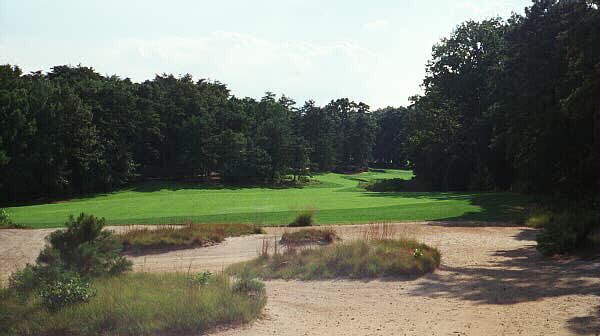
The view from the 11th tee before…
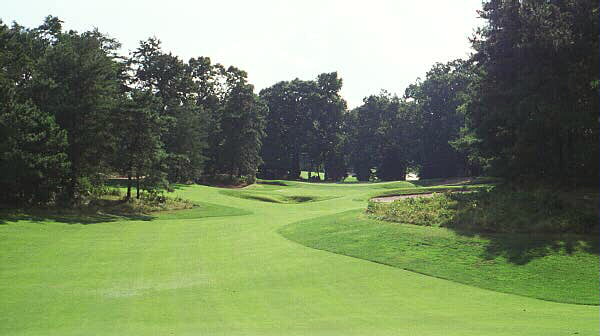
…the fairway twists its way up toward the green.
12th hole, 345 yards; Crump specifically thought every course should have a drive and pitch and run hole in addition to a drive and pitch hole, and this is an excellent pitch and run hole. The golfer always wants to hit his driver as far down the fairway as possible. From there, the hole turns sharply left, and if the drive is far enough, the golfer is left with a clear view down the length of the green. Exactly how to play the pitch shot can create indecision though as the green is open in front and runs away from the golfer. This hole is relatively level like the 7th but the angle of the green to the fairway and the two and half foot drop from front to back of the green more than creates plenty of strategic interest.
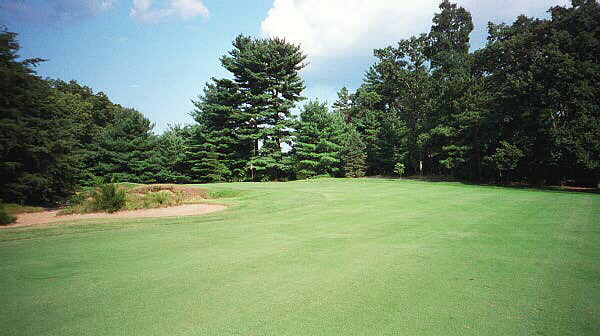
A drive long and to the right will give the golfer the best angle into the 12th green.
13th hole, 450 yards; Though Crump died before this hole was completed, he did hit balls to the spot that the 13th green now occupies and he declared that it would indeed be the site for the 13th green. So while Crump definitely deserves credit for finding the hole, the fact that it turned out so well belongs to Hugh Wilson and his brother who completed building it after Crump’s death and the end of WWI. While the 8th at Pebble Beach is often citied by many including Jack Nicklaus as their favorite approach shot in golf, the 13th at Pine Valley offers far more options without being any less thrilling.
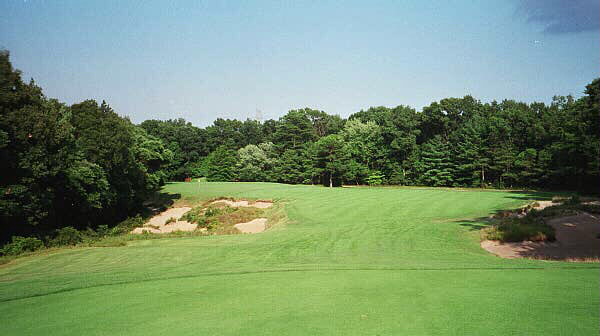
The view from 200 yards back in the fairway: do I play safely to the right or go directly over the scrub for the green? Or perhaps play a hook out to the right of the green and let it run for 30 or 40 yards? Regardless, there is no more satisfying hole to play well.
14th hole, 185 yards; Since Crump originally roamed these grounds over 90 years ago, the amount of mature hardwood trees has multiplied dramatically to where each of the holes at Pine Valley is famously isolated from the rest of the course (and the busy world in general). While trees have encroached into the sandy areas around some of the fairways and greens, trees mercifully play next to no roll in the playing strategy of the holes. In the case of the 14th, the trees turn the hole from a visual terror where the green was once on an isolated finger of land into a hole of great beauty, especially in the autumn months. Whether this would please Crump or not seems debatable but there is no doubt that he would approve of the recent selective tree removal that has occurred around this green.
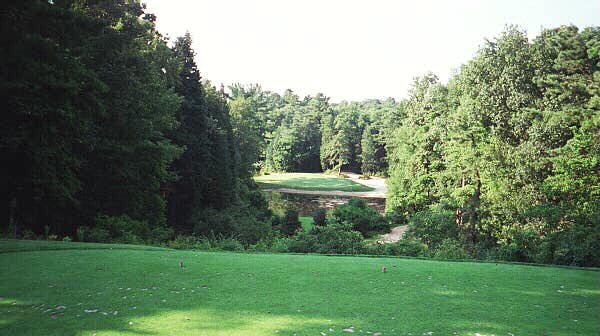
As with the 10th, the 14th has benefited from recent tree removal, especially along the right.
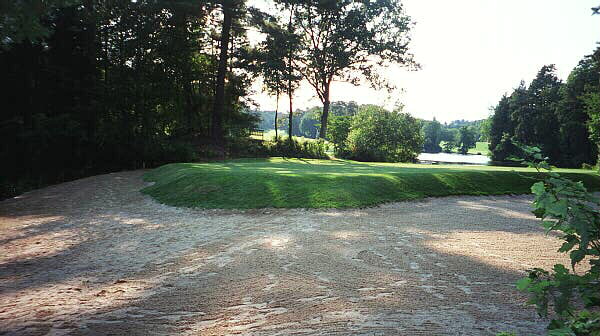
The 14th green as seen from below with the lake laping up to the bunker on the left side of the picture. This hole was built after Crump’s death and has one of the flatter putting surfaces on the course.
15th hole, 590 yards; This hole exemplifies the definition of a classic three shotter in that each shot gets progressively harder and more exacting with the fairway starting off over 60 yards wide but narrowing to less than 20 paces by the time one eventually reaches the green.The 15th was the last hole built by Wilson after Crump’s death. A Crump drawing in the clubhouse suggests that he might have been toying around with a bunker arrangement in the fairway, perhaps at the base of the hill that the green is now on. This makes some sense given that seeing an uninterrupted 420 yard stretch of fairway at Pine Valley seems odd. Conversely, the topography is ripe with challenge and such an uninterrupted stretch only adds to the variety of the overall design. Also, Crump was keen for the 15th to play as a distinctly different three shotter to the 7th, and in this regard, Wilson succeeded admirably.
16th hole, 435 yards; Another superlative use of angles with the golfer weighing risk/reward scenarios on both his tee ball and approach shot. The immense 11,400 square foot green must surely rank as one of the dozen finest in the game.
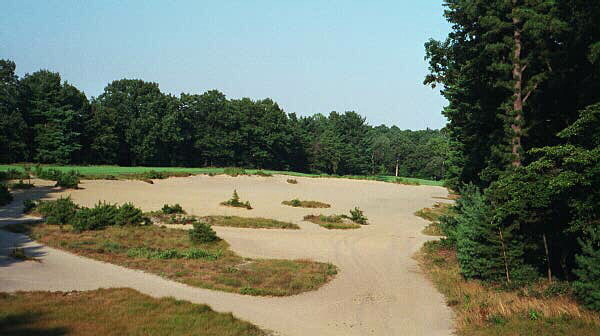
The short way home – and the longest carry – is to the right.
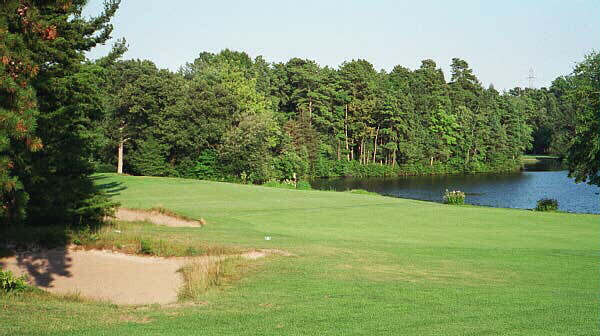
The further left the golfer goes off the tee, the more his approach shot is angled toward the lake.
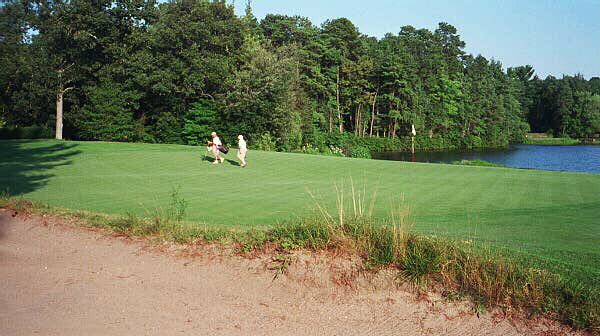
On a course full of outstanding greens, the contours found at the 16th are among the very best. Note: the green falls sharply to the right just past the day’s hole location.
17th hole, 340 yards; Though Pine Valley has long set an unmatched standard for architecture in the United States, name another famous U.S. course that has a two shotter that measures under 340 yards in its last two holes? Oakmont, Crystal Downs and Olympic are rare examples, which is a great pity but it only highlights how revolutionary George Crump truly was and how well he understood the psychology of the game. Like Donald Ross, Crump understood that there must be give and take by the course architect and he allows the golfer a chance to birdie the penultimate hole to break 80 … or 90 … or 100. Of course, rash tactics that place the greedy golfer above the day’s hole location on this sharply pitched green can be the undoing of an otherwise fine round.
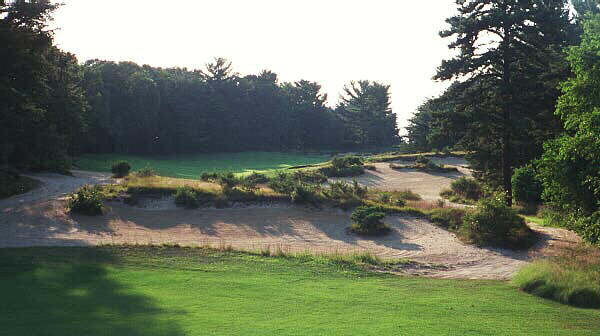
The view from the 17th tee with the green uphill and to the right, below the ‘V’ in the tree line.
18th hole, 430 yards; Along with the 2nd, this hole was a particular favorite of Crump’s and it is as heroic a finisher as one would expect. All of the playing surfaces are on a grand scale from the height of the elevated tee to the width of the fairway to the expansive 11,000 square foot green. And while the hazards are equally eye-catching, the subtle left to right slope of the fairway and the sloping green are just as likely to create problems for the good golfer as is the cacti that grows in the right greenside bunker!
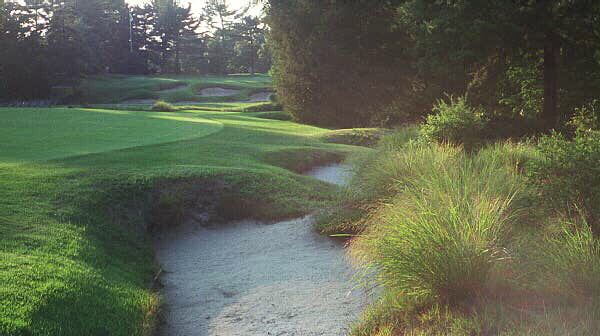
All kinds of problems await the golfer if he loses his tee ball to the right of the 18th fairway.
As seen above, given that each hole is imbued with classic design features of genuine excellence, wouldn’t it make sense that these features be emulated by architects today? Why don’t more architects build 6,700 yard courses (which is what Pine Valley now measures from the back markers) that are manageable off the tee and challenging at the green? Why not re-create the dilemma posed by the bunkerless 1st green complex? Why aren’t the waves across the 2nd green seen elsewhere? Why is the Redan copied so much more than the 3rd green? The list goes on and on.
Just as Macdonald did at National Golf Links of America, so did Crump at Pine Valley: he built a course rife with strategic options that make it as fascinating to play the 100th time as it is to play the 1st time. And given the heroic scale of the natural features and how they were incorporated into the designs, nature steals the show and makes all but a handful of other courses and their hazards seem puny and almost irrelevant.
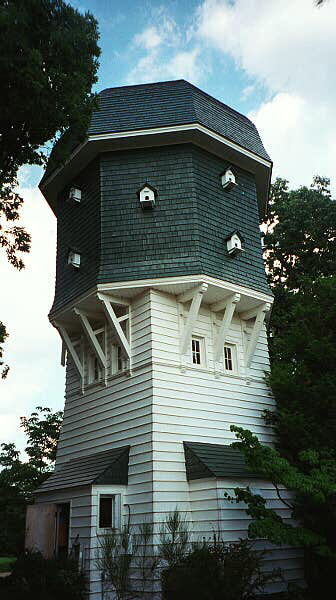
Even Pine Valley’s halfway house is special!





![The Park, West Palm (Lit 9) [2023]](https://golfclubatlas.com/wp-content/uploads/2024/12/IMG_7092-2-scaled-500x383.jpg)


